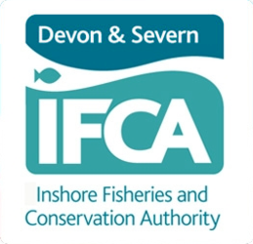Cockles
Page review/updated 04/12/2024
(Content of page last updated: 31st March 2022)
COCKLES IN D&S IFCA’S DISTRICT
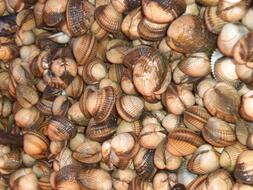
Cockles, Cerastoderma edule, are burrowing filter feeding bivalves which grow up 5cm long. They are usually found in soft to course muddy sediment to a depth range of around 5cm in the mid to lower intertidal area and can, less frequently, be found subtidally. They are highly tolerant to fluctuating salinities and as such can be frequently found in estuaries and sheltered bays. Populations of cockles can be primarily found to the south of the D&S IFCA’s District, within estuaries such as Teign, Exe and Avon. In two of these estuaries, the Teign and Exe, D&S IFCA carries out its surveys on cockle population density. The cockle surveys are conducted to monitor population changes, both in density and distribution. These data can then be used to inform any appropriate management decisions relevant to the estuary in question.
COCKLE STOCK SURVEY METHODOLOGY
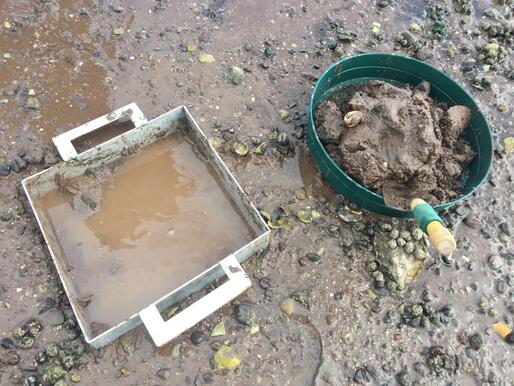
Although there is some minor variance in the survey techniques between the estuaries, the main methodology remains the same. A grid, comprised of different stations set equal distance apart, is placed over the survey area and co-ordinates generated for each station. In the Exe Estuary the distance between stations is 115m x 115m whilst in the Teign Estuary it is 75.5m x 75.5m. Officers navigate via GPS to the location of each station and randomly throw a 0.1 (metre squared) quadrat within a 10m radius. The contents of the quadrat will then be dug out (to a depth of approximately 6cm), sieved, and then any live cockles found are grouped to station level and collected for later analysis. Inaccessible sites, and sites with no live cockles are noted. To ensure that the data collected are comparable the same stations and co-ordinates are used every year.
When the survey of the beds is complete the length and width of all cockles measured using callipers. After measuring, the cockles are then sorted into age classes by determining how many annual growth rings are present on the shell (one per winter) e.g. 0 rings = current year, 1 ring = 1st winter /1 year, 2 rings = second winter/ 2 years and so on. Each year group from that station is then weighed separately (to the nearest 1g) and recorded. This is repeated for all station samples and once finished all the cockles are returned to the estuary. Based on the data collected it is possible to determine how many cockles are present per 1m2per station across the survey area, as well as providing length frequency, recruitment, and mortality data for the surveyed population. Whilst it would be preferable to take multiple samples per station, the limits of intertidal surveying mean that D&S IFCA Officers only have a brief four-hour window to work with over the spring low water tide. Data collection, therefore, needs to be both efficient and effective, the described method is employed widely amongst other IFCAs and is regarded as the appropriate methodology.
EXE ESTUARY
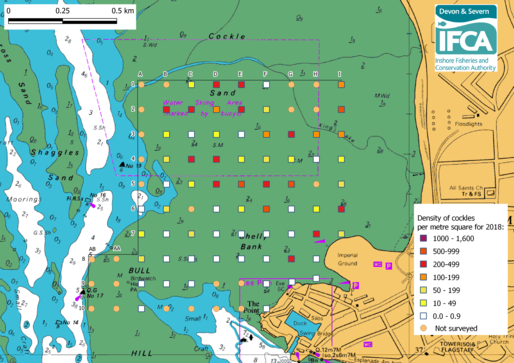
D&S IFCA began carrying out annual cockle stock assessments in 2010 on the Cockle Sands near Exmouth, in the Exe Estuary, to determine if a sustainable cockle fishery was viable. Two MSc students, from the University of Plymouth and University of the West of England, looked at the effects of harvesting cockles using an elevator harvester on macrofauna, cockle populations and sediment parameters within the Exe Estuary. This form of harvesting was found to be low impact and as a result of undertaking this research and the subsequently completed Habitat Regulation Assessment, Natural England advised that the fishery could continue. However, there was a mass mortality event of cockles in 2011, which was caused by elevated levels of two parasites that affect the cockle’s abductor muscle and preventing closure of the shell, leading to death. A further mortality event is thought to have occurred in 2014 after the winter storms (which occurred between mid-December 2013 through to mid-February 2014), resulting in depleted oxygen levels causing estuary-wide morality of all shellfish in the intertidal. These storms caused a significant loss of mussels from Bull Hill (near Cockle Sands). Despite these storms, and the corresponding loss of other bivalves (e.g. mussels) from the area, cockle densities do not seem to have been affected as dramatically. The density of adult cockles only shows a small decline, and although it is not possible to statistically test the variation in density of juvenile cockles, there appears to be some years with strong recruitment. The mortality of adult cockles and presence of parasites led to the fishery being abandoned and the newly classified production zones on the beds were declassified. Despite a lack of a commercial fishery, a low level of hand gathering has and still occurs on the Cockle Sands bed. D&S IFCA continued to conduct cockle surveys annually up until 2018, monitoring the beds for recovery and using the data to inform future management within the Exe Estuary SPA particularly in relation to hand gathering. Cockle surveys are now being conducted every two years, and the most recent (2020) cockle survey report is available here.
TEIGN ESTUARY
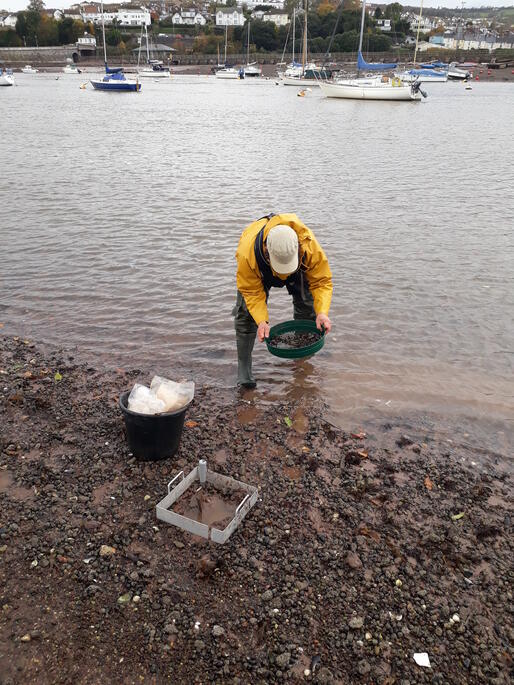
Cockles are present within the Teign Estuary and have known to be collected at low levels, both historically and up to the present day. There are currently no marine conservation designations in the Estuary, although overwintering birds such as oystercatchers are known to frequent the estuary and feed on the mussels and cockles found on the intertidal beds. The cockle populations within the Teign Estuary are important and concerns about their removal and the potential for over-exploitation by recreational fishers, particularly from The Salty intertidal bank downstream of the Shaldon Bridge, have been documented as far back as 2008. These concerns remain relevant and have been raised during D&S IFCA’s Call for Information, in 2019, on Hand Working to help inform the potential development of a Hand Working Permit Byelaw.
D&S IFCA understands the local community and ecological importance of cockles within The Salty and has undertaken survey work to establish the population structure, biomass, and distribution of cockles within the areas of the estuary where cockles are known to be present. Work conducted in 2018 showed that the cockles present in the surveyed areas displayed low biomass and density across all surveyed stations. These data have helped inform the Authority of the condition of the Teign cockle beds for its current review of Hand Working within the District. Follow up surveys were conducted in 2019 and 2020, and demonstrated no change in density or biomass over the monitoring period. These data and future surveys (which will now be completed every two years) will continue to inform management of cockle stocks within the Teign Estuary. The most recent (2020) survey report can be found here.
AVON ESTUARY
Given the designation of the Devon Avon MCZ and anecdotal reports of cockle beds on the estuary, D&S IFCA aimed to establish a baseline of cockle stocks on the estuary in 2020. Three locations were surveyed, including along the shore below Bantham Village, Cockleridge and Villa Crusoe (Figure 3). Only 8 cockles were found in total (7 at Cockleridge and 1 at Bantham) so no analyses were completed in 2020. D&S IFCA officers liaised with some hand gatherers collecting cockles for personal consumption, who reported that they had not found many cockles in the estuary and there seem to be less now than previously recorded.
D&S IFCA will revisit the Devon Avon Estuary when cockle surveys are undertaken in 2022 to ensure no significant cockle beds were missed or have been established since this survey was undertaken.
